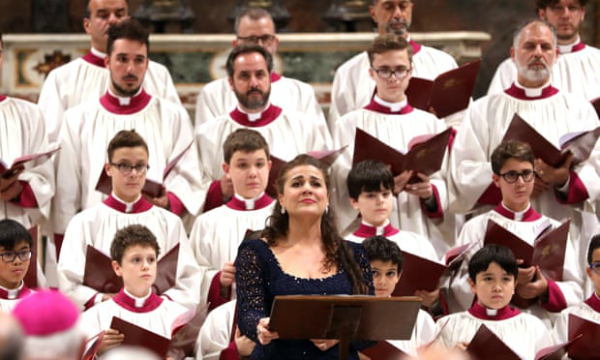 |
| Cecilia Bartoli and the Cappella Musicale Pontifica "Sistina," Sistine Chapel, Vatican City, 2017 | Franco Origlia |
Saturday marks the one-year anniversary of Cecilia Bartoli's historic live recording of 13th century ars antiqua composer Pérotin's (Perotinus') breathtakingly exquisite conductus Beata Viscera Mariae Virginis from within the hallowed walls of the Sistine Chapel.
Last Friday, November 17, 2017 marked the first time in the history of the Church that a woman was accepted into the ranks of its infamous 50 member, male exclusive choir – the Sistine Chapel Choir, which is comprised of 20 men and 30 boys.
Bartoli – arguably one of the finest mezzo-sopranos to specialize in early music repertoire – appeared resplendent as she stood front and center before the dominating force of the choir, her nondescript Indigo dress offering mute testimony to the evenly paced, stunningly reverberate, ethereal voice that would escape from within her strong, feminine frame.
The unique and much revered acoustics offered by the Sistine Chapel (which had so infamously left 18th century Rome and a visiting young Wolfgang Amadé Mozart in awe) are adequately preserved on the pontifical choir’s 16-track Christmas CD Veni Domine: Advent and Christmas at the Sistine Chapel (a previous, private session also recorded from within in the Church and released by Deutsche Grammophon in late October and December 2017.) That recording would pre-date the November 17 performance – making the DG release Bartoli's de-facto "first recording" in the Sistine Chapel with its resident choir.
In both album and in “live” video, Pérotin's hypnotically melismatic, recurrent refrain “O Mira Novitas” can be heard reverberating over onto itself as Bartoli and the collective choirs' voices echo tender cries of Marian praise and wonderment over the "purity" of the Christian Virgin Birth and the Holy Mother.
Each poetic stanza (written by the theologian Philip the Chancellor) is likewise rendered every bit as awe-inspiring as the ever-expansive frescoes of Michelangelo which bore witness to the historic occasion from the vicinity of the holy church's ceiling (and which collectively point toward the direction of the heavens, leaving glorious music trailing mere steps behind.)
The live recording, described by the Archbishop Georg Gänswein (Prefect of the papal household) as a "[translation] into sound [of] the manuscripts present in the Sistine Chapel archive... a truly precious treasure...”) was scheduled to be performed before a Papal audience, however the presently residing Pontiff, Pope Francis was unable to attend.
The decision to highlight ancient works which formerly lay dormant among the Church's musical archives follows an edict set forth in 2010 during the reign of Pope Benedict XVI to reform the Cappella Musicale Pontifica "Sistina" through the restoration and performance of neglected works housed in the Vatican Apostolic Library. Pérotin's ethereal motet is but one of the manuscripts preserved in the archive, making Bartoli's efforts doubly significant: as the first female to perform alongside the Sistine Chapel Choir within the Church itself, and as the first ever to record Pérotin's Beata viscera Mariae Virginis.
When pressed for comment regarding her historic appearance, Cecilia described the once-in a lifetime experience as an exultant moment which projected her into a state of “seventh heaven.”
When listening to Bartoli's crisp, barley-there vibrato and tender – yet altogether powerful – timbre, its quite easy to join her there.
Listen below to the recording by Deutsche Grammophon, followed by a video excerpt (with interview.) Cecilia Bartoli and the Sistine Chapel Choir sing Beata viscera Mariae Virginis, led by Msgr. Massimo Palombella:
Footnote:
Pérotin (Latin Perotinus, also known as "Perotin the Great") was a 13th century European composer, believed to be of French descent, who composed for the Church of Notre Dame in both polyphonic and the ars antiqua style. He is one of the only composers of his era whose name can be authentically attributed to individual compositions, and has been cited as a "Magister," or Master - indicative of academic pedigree and of professorship. He pioneered the three and four-part polyphonic styles of organa (organum triplum and quadruplum), notable for being the earliest form of polyphonic European Church music.
External links:
- Extended interview, Cecilia Bartoli (Gramilano)
- Official Notice of Press Conference, 20.10.2017 (Holy See Press Office)
- Veni Domine - album at Deutsche Grammophon
- Rose.

No comments:
Post a Comment